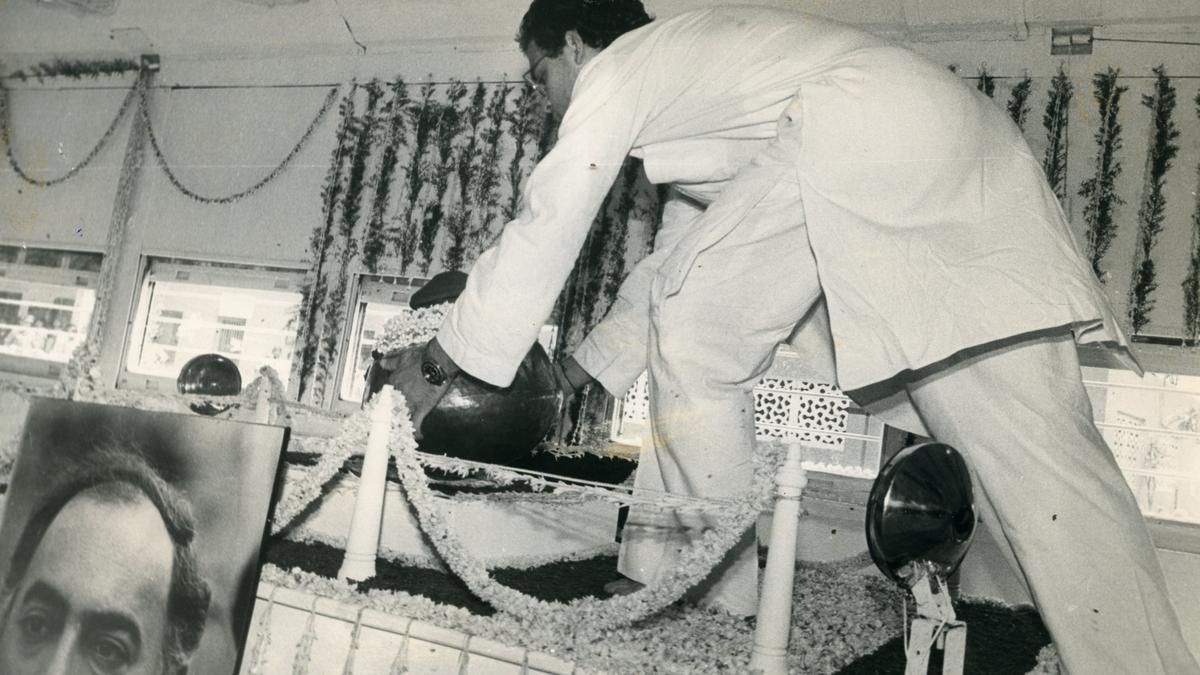Rahul Gandhi placing an urn containing the ashes of Rajiv Gandhi on a special train at the New Delhi railway station in 1991.
| Photo Credit: The Hindu Archives
Rahul and Priyanka Gandhi immersing the ashes of their father, Rajiv Gandhi, in the Sangam at Allahabad.
| Photo Credit:
The Hindu Archives
For decades, this was perhaps one of the best kept secrets of Indian Railways. When the locomotive of a special train carrying the ashes of the former Prime Minister Rajiv Gandhi failed, the Railways had a contingency plan that worked flawlessly to keep the wheels rolling. No one knew of the failure and immediate success in operating one of the most important trains in history.
On the night of May 21, 1991, Rajiv Gandhi was assassinated by a suicide bomber of the Liberation Tigers of Tamil Eelam during an election campaign at Sriperumbudur, near Chennai. The mortal remains were flown to Delhi for cremation. The ashes were immersed in the Sangam at Allahabad (now Prayagraj).
The train was to traverse about 675 km with multiple stops where thousands of mourners were waiting to pay homage to the departed leader. We were told that Rajiv’s wife, Sonia Gandhi, would be on board along with their children, Rahul Gandhi and Priyanka Gandhi. With reports of a large number of emotionally charged people gathering along the route to have a glimpse of the urn carrying the ashes, the Railways had to ensure a smooth travel. The whole country was in shock over the assassination of Rajiv Gandhi.
I was asked to provide a diesel locomotive for the special train. I was a young, rather inexperienced Divisional Mechanical Engineer in charge of the Mughalsarai Diesel Shed of Northern Railway. The shed had nearly 60 WDM4 locomotives that had become rather old. The Railways had imported 72 of these locomotives built by the Electro-Motive Division of General Motors, U.S. They were ageing and were not very reliable by the time I was put in charge of them. When called upon to provide a WDM4 for the special train, I was worried that the locomotive might fail en route and cause massive embarrassment to the Railways. Any failure could delay the train by several hours until a relieving loco was found. What would happen if the train got stranded in the middle of nowhere with Rajiv Gandhi’s family and top Congress leaders on board? That would have been the biggest embarrassment for the Railways. The milling crowds at the stations en route could have created mayhem.
After many deliberations, I decided to deploy a spare locomotive to escort the special train. The idea was that it could be quickly brought in to continue the journey in case the first locomotive failed.
My operating colleague told me that he was not responsible for any failure and that I would be answerable for it. I told him that it was not a matter of who was accountable but to ensure that the train journeyed through the land unimpeded.
And our worst fears came true. The locomotive failed halfway on its route. Though Murphy’s Law prevailed, our Plan B worked flawlessly. Without anybody even noticing that the engine had developed a snag, the spare engine came to the rescue of the stranded special train and the wheels kept rolling. The journey continued as though nothing had happened. There was nothing to be embarrassed about and nothing to celebrate either. This story was never told.
Later, the Railways built thousands of more advanced versions of the same EMD locomotive in the Diesel Locomotive Works, Varanasi that transformed the rail traction of Indian Railways. We are no longer dependent on imports.
More recently, we built the much-celebrated Vande Bharat Express in the Integral Coach Factory, Chennai, which has the propulsion distributed along the train and failure of a unit is not a major challenge.
shubhranshu@msn.com
Published – February 09, 2025 03:53 am IST
